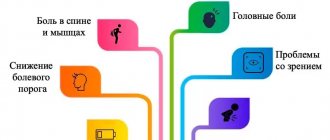Basics of psyche
Psyche is the ability of our brain to reflect objective reality for interaction with the external environment. It consists of several structures that precede each other: properties, processes, qualities and states.
Mental properties include such concepts as strength, calmness, poise. The concept of mental processes refers to emotions, memory, feelings, sensations. Among the qualities of the psyche are intelligence, character, temperament, and abilities. Mental states include, for example, mood.
Any changes in these systems that do not correspond to a normal adequate response lead to mental disorders and the development of mental disorders.
Conventionally, such disorders are divided into syndromes. Based on them, mental illness is subsequently diagnosed and treated.
The following syndromes are distinguished:
- asthenia. Accompanied by rapid fatigue, low performance, and mood lability. Such people are extremely impressionable, sentimental and irritable. This syndrome is characterized by frequent headaches and sleep disturbances. In general, asthenia is accompanied by a loss of strength and indifference to what is happening around. It is not a pathognomonic symptom, as it can accompany various diseases;
- obsessions and compulsions. The main criterion for these disorders is obsession. Obsessive thoughts and actions accompany a person constantly, disrupting his way of life. An example of this condition is an excessive preoccupation with cleanliness. A person is constantly visited by thoughts that all objects around are simply teeming with bacteria. Because of this, he develops an obsessive desire and action to constantly wash his hands, otherwise viruses will attack the body and cause a deadly disease. Such disorders include all sorts of annoying fears: darkness, spiders, great heights, etc.;
- affects. The most common group of mental disorders. Affective disorders are accompanied by a change in mood in one direction or another, its deterioration or a sharp rise. Among the most common disorders in this area are depression and mania;
- senestopathy. These are unusual sensations inside and on the surface of the body, not associated with any organ disease. Manifest in the form of stabbing, tightening, itching sensations, burning sensations, distension, gurgling, etc. They are of an indefinite nature. And often patients use their own characteristics to paint a picture: itching in the head, squelching in the chest;
- hypochondria. A persistent belief that a person is developing a disease. Neither examinations nor doctors' arguments can dissuade him from this belief;
- illusions. This is a distorted perception of real-life objects. They can also occur in healthy people. The difference between healthy and pathological illusions is that the latter appear under the influence of strong feelings. Most often, anxieties and fears are as follows: the perception of a shadow on the wall as a terrible monster, an image on the wallpaper as a ball of snakes;
- hallucinations. Perception of something that does not exist in reality;
- rave. The basis of delusional disorder is inadequate judgment. But they are so persistent and significant for the patient that it is impossible to disabuse him of them in any way;
- catatonia. These are motor disorders manifested by agitation or immobility, freezing in one position;
- change of consciousness. Includes several types of violations: orientation in the area, in time, in one’s personality; thinking; memory. There is a loss of connection with reality, patients cannot explain what is happening;
- dementia. Accompanied by a decrease in intellectual activity and mental processes in general. There is no opportunity to assimilate new information or apply existing knowledge in practice.
It is very important for a specialist to be able to recognize such symptoms in a patient. After all, on their basis, specific treatment for mental disorders will be prescribed, and for each syndrome there is an individual approach.
When to seek professional help
Perhaps you or your loved ones have developed suspicious signs of one or another type of psychological disorder. This may include insomnia, fear, depression, short-term memory loss, loss of spatial orientation, and even hallucinations. In such cases, it is recommended to immediately contact a specialist!
Modern medicine has long used special diagnostic tests that make it possible to determine a real mental disorder in the early stages. So often the problem of simple emotional exhaustion and fatigue can be mistaken for a full-fledged mental disorder and vice versa. Therefore, you should never self-diagnose and try to recover by taking antidepressants or sedatives.
The Korsakov clinic uses a modern recovery method, approved not only by the Russian healthcare system, but also by a number of Western experts. The complex of mental health treatment measures also includes establishing a lifestyle, reducing stressful situations, establishing a healthy diet, fortifying the body, and protecting oneself from social and everyday problems. In the process of in-depth psychological assistance, a person’s social activity is restored and negative factors are neutralized. As a result of such actions, the nervous system usually returns to normal.
We also recommend reading the article about gambling addiction.
Classification of mental disorders
The human psyche requires correction and treatment when its condition differs from normal. At the same time they talk about mental disorder.
According to ICD 10, the following mental diseases are distinguished:
- Organic mental disorders. These are mental disorders associated with damage to brain tissue. Its symptoms include affects, decreased cognitive function, dementia, delusions and hallucinations, catatonia, and emotional disturbances.
- Schizophrenia and schizotypal disorders. These conditions are characterized by productive and negative symptoms. Productive ones include delusions, hallucinations, and mental disorders. Negative manifestations include poverty of emotions, poverty of speech, lack of will, pleasure, motivation and desire.
- Affect disorders. Affect is a person’s expression of his emotions and feelings. The most common affective disorder is depression. It is accompanied by low mood and an inability to get pleasure. There are postpartum, alcoholic, seasonal, melancholic, acute, and minor forms. Other affective disorders include dysthymia (mood disorder) and manic-depressive syndrome.
- Manic-depressive syndrome is accompanied by alternating episodes of depression and mania. Mania is the inverse opposite of depression. It is manifested by a pronounced increase in mood, motor agitation and accelerated mental activity. Manic syndrome is also distinguished as a separate pathology.
- Neurotic disorders. Reversible changes in the psyche, accompanied by asthenic, obsessive syndromes, hysteria, as well as a decrease in mental and physical activity. These include neuroses, neurasthenia, obsessive-compulsive and anxiety disorders.
- Behavioral disorders. This group of diseases includes eating disorders - anorexia, bulimia, sexual disorders, and desire disorders.
- Pathological changes in personality and behavior in adulthood. These include paranoid, schizoid, dissocial, emotionally unstable, mixed disorders. Persistent personality disorder, pathology of habits, desire for arson and theft, violation of gender identity and sexual preference.
- Mental retardation. It is characterized by a decrease in cognitive functions and manifests itself in mild, moderate and severe degrees.
- Mental development disorders. It manifests itself in delayed speech development, counting, writing and reading skills, motor and psychomotor functions.
- Emotional and behavioral disorders of childhood and adolescence.
Age limits
Mental disorder in the stronger sex starts much earlier than in the female. The first signs of schizophrenia in men can be traced back to childhood, at the age of 2-4 years. The behavior is noteworthy: motor activity, which is usually increased at this age, decreases. Boys neglect the company of their peers. They are looking for solitude.
The mood is usually labile. Kids are capricious and whine for no reason. Boys with developing schizophrenia are not inclined to show strong emotions and withdraw into themselves. During a conflict situation, they are unable to respond to an insult.
Such children are characterized by groundless fears. The emotions shown are often inappropriate. Acquired skills are lost.
Given the nonspecificity of symptoms, it is difficult to suspect a schizophrenic disorder. The child is accused of self-indulgence and blamed on age. Meanwhile, the disease continues to develop.
The manifestation of the disease in adolescence, up to 16 years, becomes common among males. Social isolation is typical when a teenager stops communicating with friends, avoids mass gatherings, and becomes indifferent to loved ones.
Guys are interested in mysticism: magic, esotericism, extrasensory perception. A sudden fascination with religion is a pretty telling sign.
Young men stop taking care of themselves, brushing their teeth and washing. Oddities appear in facial expressions and movements: twitching, harshness.
In teenage boys, symptoms are attributed to hormonal changes. Features: unsociability, inactivity, emotional instability.
It is believed that the favorable age for the development of male schizophrenia is 16-35 years, but the peak incidence occurs at 30 years. For comparison: for women, the onset of the disease is typical at 28-37 years of age.
General signs of schizophrenia in men, different from women:
- severe course, deep destruction of personality;
- characterized by a chronic course. Women are more prone to a sluggish and paroxysmal form;
- higher incidence due to increased brain vulnerability;
- brightness, severity of pathological changes, quickly leading to loss of ability to work.
Where to start treatment
If you suspect the development of a mental disorder, the help of a psychiatrist is required. At the appointment, after a thorough examination, the doctor chooses how the patient will receive treatment:
- outpatient;
- in hospital;
- dispensary registration.
According to Article 29 of the Criminal Code of the Russian Federation, a patient can be hospitalized without the consent of him and his relatives in a hospital if his condition causes:
- harming oneself and others;
- inability to perform basic self-service actions;
- deterioration of the condition if the patient is not hospitalized.
Previously, treatment of the mentally ill was not distinguished by humanism and delicacy. For example, in 1936, the Portuguese doctor Egas Moniz proposed a method of lobotomy. That is, the removal of some parts of the brain. After 20 operations performed, he announced the results. seven experimental subjects were completely cured of mental illness, another seven showed noticeable improvements. For the rest, the condition remained at the same level.
Surprisingly, this method has gained great popularity, and its author was even awarded the Nobel Prize in Medicine.
Currently, therapy for the mentally ill is carried out in several directions and has a more gentle approach:
- pharmacotherapy;
- psychotherapy;
- social rehabilitation.
Depression
According to statistics, the prevalence of depression
continues to grow (up to 20% of the population) and in the coming years may overtake cardiovascular morbidity. Mild forms of depression are especially common, occurring latently, with not obvious symptoms.
Depression is not an invention of psychiatrists, but a serious illness!
Depression is most widespread among urban residents, resulting from information overload, sleep-wake rhythm disturbances, abuse of stimulants, etc.
General principles of drug therapy
Drug therapy is the main and most effective method of treating mental disorders. And it is a priority method of therapy during periods of exacerbation of mental illness.
Its success is based on the correct choice of psychopharmacological substances, the method of their administration, as well as changes in therapy depending on the manifestations of the disease. Each case of its prescription must be clinically justified and based on the individual characteristics of the patient and the symptoms of the disorder.
It should be understood that psychotropic drugs act gradually, cumulatively. That is, you should not expect an immediate effect from the first days of treatment.
It is very important to strictly adhere to the dosage and course of taking medications prescribed by your doctor. With an independent dose reduction or sudden withdrawal, mental disorders are observed in the form of severe anxiety, poor sleep, hallucinatory exacerbations, as well as somatic disorders associated with autonomic dysfunction. It is also possible to develop withdrawal syndrome and drug resistance. Therefore, upon achieving a lasting positive result, the dose of the medication should be reduced gradually.
Only in the case of unsuccessful long-term drug treatment is it practiced to abruptly discontinue the drug administered in increased doses. After a short period of time, therapy is resumed using the zigzag method - rapidly increasing the dose.
Attention is also paid to the safety of the drug. The fact is that many psychotic drugs produce adverse reactions. The most common of them are loss of strength, lack of motivation to action, apathy, lethargy, and decreased motor activity. All this is called “behavioral toxicity.” In addition, there are drugs that are incompatible with other medications used to treat somatic diseases. Therefore, the doctor strives to prescribe medications that are as safe as possible for the patient’s health. Also eliminating the risk of overdose.
The method of drug administration depends on the patient's condition. They can be prescribed orally (tablets, syrups, suspensions) or parenterally (intramuscularly). During the period of exacerbation, they resort to continuous administration. In this case, intravenous or intravenous drip injections have a good effect.
Classification of psychopharmacological drugs
The choice of drug for the treatment of mental disorders depends on its symptoms. The following groups of psychotic drugs are distinguished:
| Group name | Action | Indications |
| Neuroleptics | Antipsychotic effect, sedation, reduction in the severity of psychomotor reactions, relief of feelings of fear, | Psychoses, severe mental disorders |
| Antidepressants | Antidepressant and stimulating effect, relieves anxiety and irritability. Eliminate apathy and improve mood. Normalizes sleep and appetite. | Depression, bipolar disorder, obsessive-compulsive disorder, neurosis, sleep correction. |
| Tranquilizers or anxiolytics | Eliminate anxiety and fear, exhibit a calming and relaxing effect, hypnotic and anticonvulsant effects | Anxiety disorders |
| Normotimics | Mood stabilization | Bipolar disorder, depression, dysthymia, schizotypal disorder |
| Sleeping pills | Sleeping pills, sedative, relaxant | Sleep disorders |
| Nootropics | Normalize metabolism in brain tissue. Improves mental activity. Resume cognitive functions | Acquired dementia, neurotic disorders |
| Psychostimulants | Activation of mental activity. Accelerates thought processes, eliminates lethargy and drowsiness. Improves performance and mood. | Asthenic syndrome in various psychopathologies |
BAR
Bipolar affective disorder (BID) is a disorder in which manic (emotional, energetic, cheerful, but often irritable) and depressive episodes alternate. BAR has two forms. Type I includes one or more episodes of mania or major depression. In type II bipolar disorder, there are short episodes of hypomania (a milder form of mania), but depressive phases predominate. There is also cyclothymia - multiple cyclical mood swings in the form of hypomania and mild depression for at least two years of life.
What therapy is used? Medicines are the main, but not the only effective treatment for bipolar disorder: in the case of taking medications alone (these are mood stabilizers, antidepressants, and sometimes antipsychotics and tranquilizers), the relapse rate in the next two years is approximately 60%.
Some patients with bipolar disorder may have problems with adherence to medications and/or the effects of the disorder. This is where psychotherapy can make a difference. According to the American Psychological Association, the psychotherapy of choice for the treatment of bipolar disorder may include psychoeducation, CBT, interpersonal and social rhythm therapy, and family-focused therapy.
How does it help? Psychotherapy allows us to understand the mechanisms of the disease and the consequences of its impact on social life. Mood is stabilized, hospitalizations are reduced, and the patient gains cognitive and behavioral skills to manage symptoms. Thanks to this, the quality of life and relationships with other people improve.
How long does it last? A difficult question: bipolar disorder often occurs in parallel with other disorders, such as addictions, and this affects the duration of therapy. Most likely, with bipolar disorder, psychotherapy will be supportive in nature, that is, it will be long-term. Psychoeducation and normalization can take 10–15 sessions.
Psychotherapy
At the stage of recovery, reducing the severity of symptoms and establishing remission, the most effective method of correcting the patient’s mental state is psychotherapy.
There are several types of it:
- individual;
- group;
- family.
In the first stages of working with a patient, individual therapy is considered more effective. It will help establish contact with the patient and reduce negative attitudes, if any. Her sessions establish an intimate atmosphere and build trusting relationships. It gives the patient the opportunity to open up and discuss his problem from all sides.
The goal of individual psychotherapy is to help a person understand his plans for the future and implement them as quickly as possible. In addition, it allows you to correct the patient’s behavior and teach him new behavioral reactions.
There are many types of this type of therapy:
- cognitive-behavioural;
- psychoanalysis;
- suggestive;
- existential;
- bodily;
- rational, etc.
Cognitive-behavioral therapy, which is used for a variety of mental illnesses, is particularly distinguished. It is based on the opinion that a person’s psychological dysfunctions are associated with his incorrect beliefs and thoughts, as well as stereotypical thinking, which are reflected in the patient’s behavior. But it can be corrected by encouraging desirable actions and ignoring undesirable ones.
This method combines 2 types of mental therapy: cognitive and behavioral. His goal is to convey to the client the errors of his thinking and behavior, which are the cause of all his troubles.
When to use:
- personality disorders;
- affective disorders;
- hypomania;
- neurotic disorders.
Therapy is also used for obsessive-compulsive disorders. As you can see, this method of treatment is quite delicate and allows you to solve the problem gradually and consciously.
But not everyone follows this path. Thus, one American, 19 years old, had an obsession with constantly washing himself. One day, unable to tolerate his behavior any longer, he resolved the issue radically: he shot himself in the head. However, this did not bring the expected effect. The guy did not die, but only damaged the part of the brain that was responsible for his obsession. After this, the young man’s life returned completely to normal, and the pathology never returned.
Note: this method of treating pathology is a complete accident. Repeating is not recommended!
Stress Reactions: Complicated Grief
Every person experiences the loss of a loved one in their life. In response to such events, a complex of reactions occurs, which is called grief. Grief is characterized by:
- strong emotions (longing and sadness, often guilt and anger, “emotional numbness”);
- focusing on the loss (in thoughts a person often turns to events associated with the loss, experiences a feeling of a comprehensive lack of the departed);
- behavior associated with grief (avoidance or, on the contrary, excessive immersion and contact with things and events related to the loss).
How to recognize complicated grief?
In 9 out of 10 cases, the person himself adapts to the new reality after loss. If the condition does not improve for 6 months or more and goes beyond expected norms (cultural or religious), they speak of a complicated or prolonged grief reaction. It needs therapy because it prevents a person from functioning in various areas of life: problems appear at work, in personal relationships, social isolation.
What therapy is used? To combat this condition, there is a specially developed model of psychotherapy - complicated grief therapy (CGT). It is based on attachment theory and combines cognitive, exposure, imagery and interpersonal aspects. TOG has proven its effectiveness in large randomized controlled trials.
How does it help? The goals of therapy for complicated grief are to find what prevents adaptation to loss and help with this adaptation. Research notes that people who underwent TOG experienced improvements in well-being significantly faster than those who received interpersonal therapy—51% versus 28%.
How long does it last? About 4 months - 16 sessions of 45-60 minutes.
Family and group psychotherapy
Group therapy involves forming a group of people under the supervision of a psychotherapist.
The group members communicate with each other about the most secret things that they did not dare to tell anyone before. Participants in the conversation talk about their problems, feelings and experiences. By opening up to others, they get to know themselves, their world, and look for solutions to their problems. The basis of successful group therapy is sincerity in statements. Family therapy is based on the opinion that the family is an integral structure that lives according to its own laws. The relationships between its members play a special role in the dynamics of the mental disorder of one of them.
Family psychotherapy allows you to analyze relationships in the family and find out what exactly leaves a negative imprint on the patient, and forces him to turn on compensatory mechanisms in order to survive conflict in the family.
It has been established that the most common problem in family relationships is spouses copying the behavior patterns of their parents. They transfer to their spouse and children the same actions that were carried out by their mothers or fathers. That is, it is a kind of transfer. And the marriage partner or child is perceived in a special, mostly unflattering light (capricious, demanding, tyrant, etc.). Because of this, difficulties then appear in family relationships, leaving a destructive imprint on the psyche of one of its members.
Along with psychotherapy, patients with mental disorders in remission are subjected to social rehabilitation. It gives them the opportunity to develop basic behavioral skills. For example, taking care of your appearance, cleaning the apartment, going to the store, traveling on public transport, as well as gaining knowledge that will help patients finish school or get a profession.
Psychosomatic diseases
The diagnostic criteria for many diseases (such as irritable bowel syndrome, neurogenic bladder, bronchial asthma, restless legs syndrome, hypertension, obesity, etc.) are being revised.
In hospitals, separate psychosomatic departments are already beginning to be created; in medical universities, psychosomatics is beginning to be identified as a separate area; all general practitioners are trained to identify and help people with psychosomatic diseases.
Even 20 years ago, such diseases could be spoken of as exceptional and rare conditions; now psychosomatic symptoms are found in more than 50% of patients in regular therapeutic hospitals.
Dependence on several psychoactive substances (polydependence)
This category includes people who, as a rule, have quietly become psychologically and often physically dependent on the use of a psychoactive substance (psychoactive substances (PAS) are drugs that can cause pathological dependence, these include all types of drugs, alcohol, tobacco, caffeine, tranquilizers and etc.). Moreover, this is not necessarily one substance, as for example in tobacco smokers, alcohol in alcoholics, and coffee in “coffee drinkers.”
Polydependency is characterized by the inability to stay sober for a long time, there is a need to “cloud your consciousness” with something, to experience euphoria or relaxation with any available psychoactive substance; surfactants can change, alternate or mix.
A long period without using surfactants becomes unbearable. And if drugs are present in the arsenal of substances taken, then they quickly “displace” other surfactants, drug addiction forms and the addicted person will sooner or later come to the attention of a narcologist and begin treatment.
In cases where surfactants other than drugs are taken, such patients rarely come to the attention of doctors. In the 20th century, such disorders were relatively rarely encountered and described, but in our time, almost every person can easily find a person with such an addiction in his environment.
Schizophrenia
This mental disorder affects approximately 1.5% of the population. Its most common manifestations are considered to be oddities in thinking, delusional ideas, and disturbances of volitional processes (unwillingness or inability to do anything). In addition, an optional, but extremely unfavorable symptom of schizophrenia is auditory hallucinations.
Photo: istockphoto.com









